GSBS6005 - Target Australia: Marketing Management & Planning Report
VerifiedAdded on 2023/01/19
|15
|3835
|64
Report
AI Summary
This report provides a situational analysis of Target Australia's marketing strategies and proposes improvements to address current challenges. It identifies issues such as poor market positioning and a lack of technological advancement in online sales and distribution. The report outlines three objectives for the next 12 months, utilizing the SMART goal-setting criteria: enhancing customer service, improving product quality and profit margins, and leveraging social media for brand awareness. It also discusses market segmentation, targeting modern moms and families, and positioning strategies to differentiate Target from competitors. The report details a marketing mix strategy focusing on product, price, promotion, and distribution, aiming to reposition Target as a mid-tier departmental store with high-quality products and effective marketing campaigns. The conclusion emphasizes the role of the marketing plan in guiding the company's tactics and strategies for improved market performance.
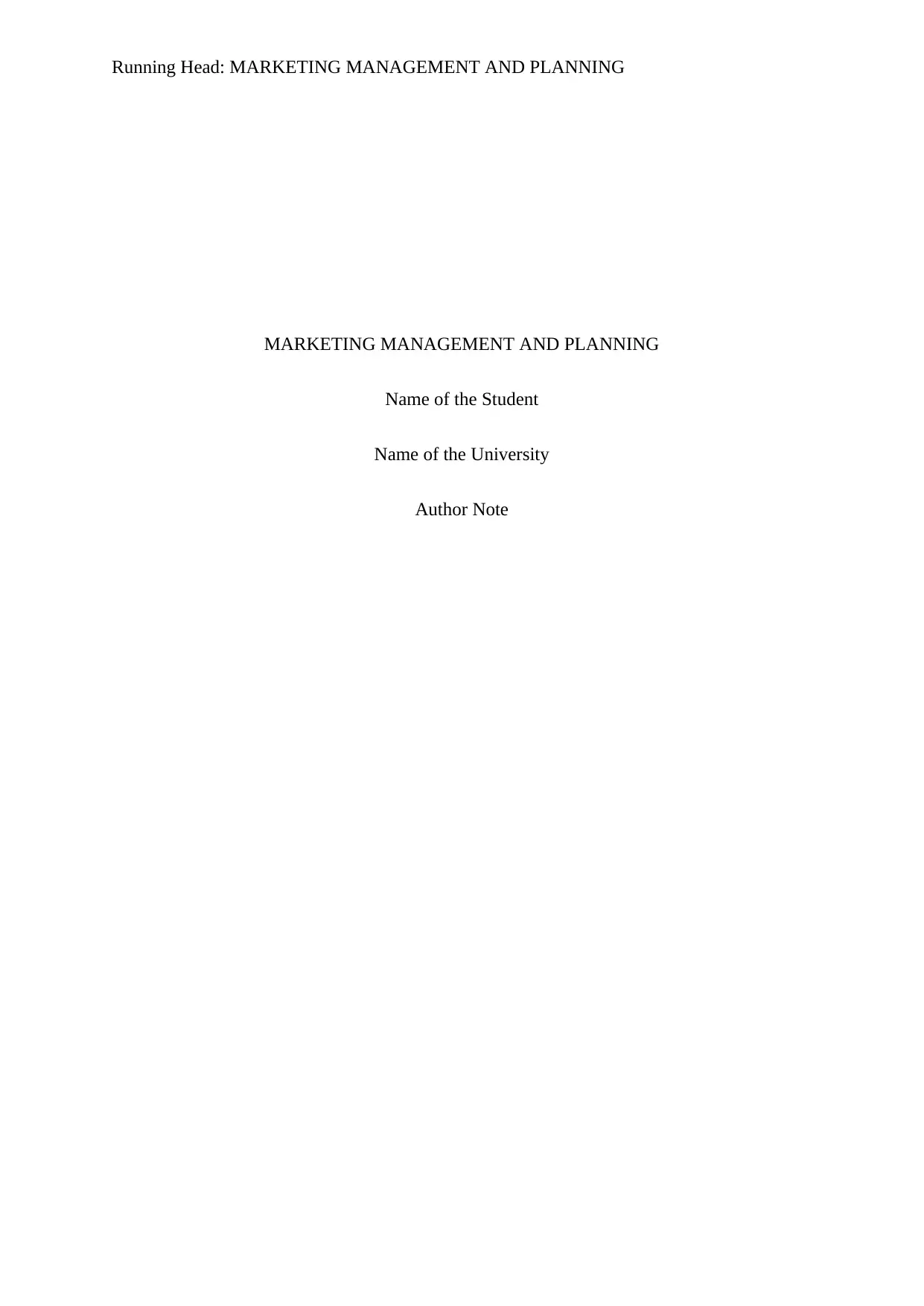
Running Head: MARKETING MANAGEMENT AND PLANNING
MARKETING MANAGEMENT AND PLANNING
Name of the Student
Name of the University
Author Note
MARKETING MANAGEMENT AND PLANNING
Name of the Student
Name of the University
Author Note
Paraphrase This Document
Need a fresh take? Get an instant paraphrase of this document with our AI Paraphraser
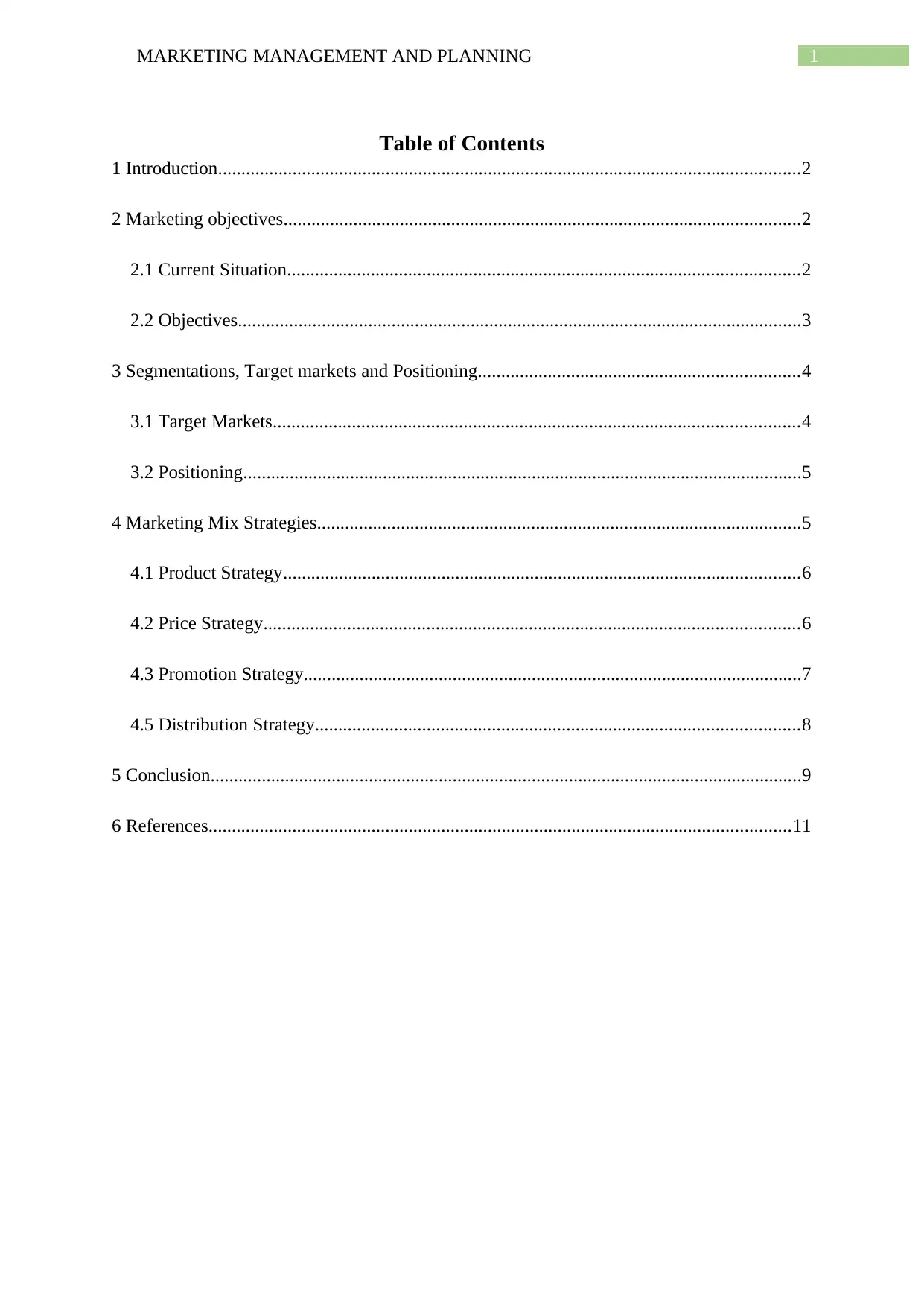
1MARKETING MANAGEMENT AND PLANNING
Table of Contents
1 Introduction.............................................................................................................................2
2 Marketing objectives...............................................................................................................2
2.1 Current Situation..............................................................................................................2
2.2 Objectives.........................................................................................................................3
3 Segmentations, Target markets and Positioning.....................................................................4
3.1 Target Markets.................................................................................................................4
3.2 Positioning........................................................................................................................5
4 Marketing Mix Strategies........................................................................................................5
4.1 Product Strategy...............................................................................................................6
4.2 Price Strategy...................................................................................................................6
4.3 Promotion Strategy...........................................................................................................7
4.5 Distribution Strategy........................................................................................................8
5 Conclusion...............................................................................................................................9
6 References.............................................................................................................................11
Table of Contents
1 Introduction.............................................................................................................................2
2 Marketing objectives...............................................................................................................2
2.1 Current Situation..............................................................................................................2
2.2 Objectives.........................................................................................................................3
3 Segmentations, Target markets and Positioning.....................................................................4
3.1 Target Markets.................................................................................................................4
3.2 Positioning........................................................................................................................5
4 Marketing Mix Strategies........................................................................................................5
4.1 Product Strategy...............................................................................................................6
4.2 Price Strategy...................................................................................................................6
4.3 Promotion Strategy...........................................................................................................7
4.5 Distribution Strategy........................................................................................................8
5 Conclusion...............................................................................................................................9
6 References.............................................................................................................................11
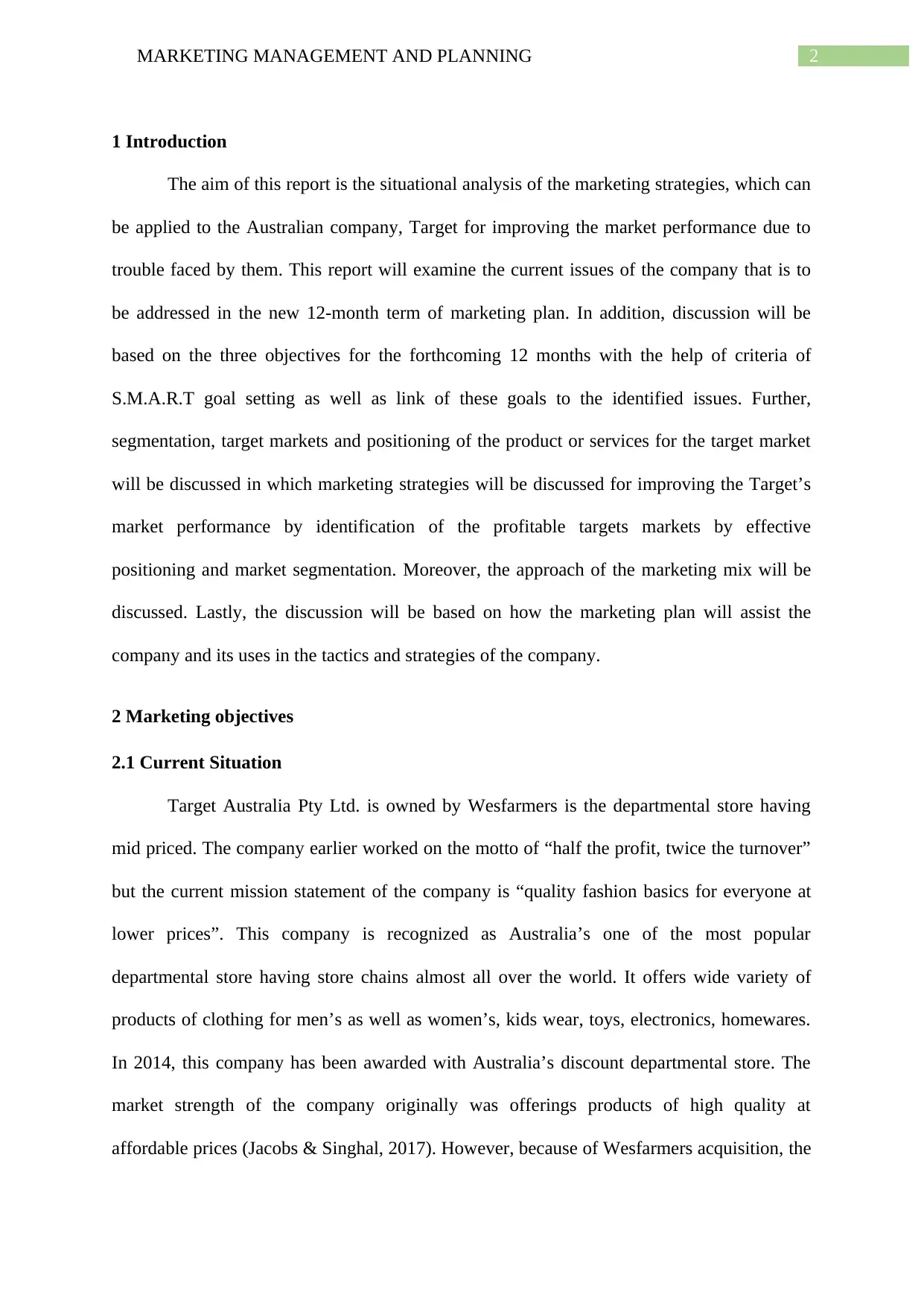
2MARKETING MANAGEMENT AND PLANNING
1 Introduction
The aim of this report is the situational analysis of the marketing strategies, which can
be applied to the Australian company, Target for improving the market performance due to
trouble faced by them. This report will examine the current issues of the company that is to
be addressed in the new 12-month term of marketing plan. In addition, discussion will be
based on the three objectives for the forthcoming 12 months with the help of criteria of
S.M.A.R.T goal setting as well as link of these goals to the identified issues. Further,
segmentation, target markets and positioning of the product or services for the target market
will be discussed in which marketing strategies will be discussed for improving the Target’s
market performance by identification of the profitable targets markets by effective
positioning and market segmentation. Moreover, the approach of the marketing mix will be
discussed. Lastly, the discussion will be based on how the marketing plan will assist the
company and its uses in the tactics and strategies of the company.
2 Marketing objectives
2.1 Current Situation
Target Australia Pty Ltd. is owned by Wesfarmers is the departmental store having
mid priced. The company earlier worked on the motto of “half the profit, twice the turnover”
but the current mission statement of the company is “quality fashion basics for everyone at
lower prices”. This company is recognized as Australia’s one of the most popular
departmental store having store chains almost all over the world. It offers wide variety of
products of clothing for men’s as well as women’s, kids wear, toys, electronics, homewares.
In 2014, this company has been awarded with Australia’s discount departmental store. The
market strength of the company originally was offerings products of high quality at
affordable prices (Jacobs & Singhal, 2017). However, because of Wesfarmers acquisition, the
1 Introduction
The aim of this report is the situational analysis of the marketing strategies, which can
be applied to the Australian company, Target for improving the market performance due to
trouble faced by them. This report will examine the current issues of the company that is to
be addressed in the new 12-month term of marketing plan. In addition, discussion will be
based on the three objectives for the forthcoming 12 months with the help of criteria of
S.M.A.R.T goal setting as well as link of these goals to the identified issues. Further,
segmentation, target markets and positioning of the product or services for the target market
will be discussed in which marketing strategies will be discussed for improving the Target’s
market performance by identification of the profitable targets markets by effective
positioning and market segmentation. Moreover, the approach of the marketing mix will be
discussed. Lastly, the discussion will be based on how the marketing plan will assist the
company and its uses in the tactics and strategies of the company.
2 Marketing objectives
2.1 Current Situation
Target Australia Pty Ltd. is owned by Wesfarmers is the departmental store having
mid priced. The company earlier worked on the motto of “half the profit, twice the turnover”
but the current mission statement of the company is “quality fashion basics for everyone at
lower prices”. This company is recognized as Australia’s one of the most popular
departmental store having store chains almost all over the world. It offers wide variety of
products of clothing for men’s as well as women’s, kids wear, toys, electronics, homewares.
In 2014, this company has been awarded with Australia’s discount departmental store. The
market strength of the company originally was offerings products of high quality at
affordable prices (Jacobs & Singhal, 2017). However, because of Wesfarmers acquisition, the
⊘ This is a preview!⊘
Do you want full access?
Subscribe today to unlock all pages.

Trusted by 1+ million students worldwide
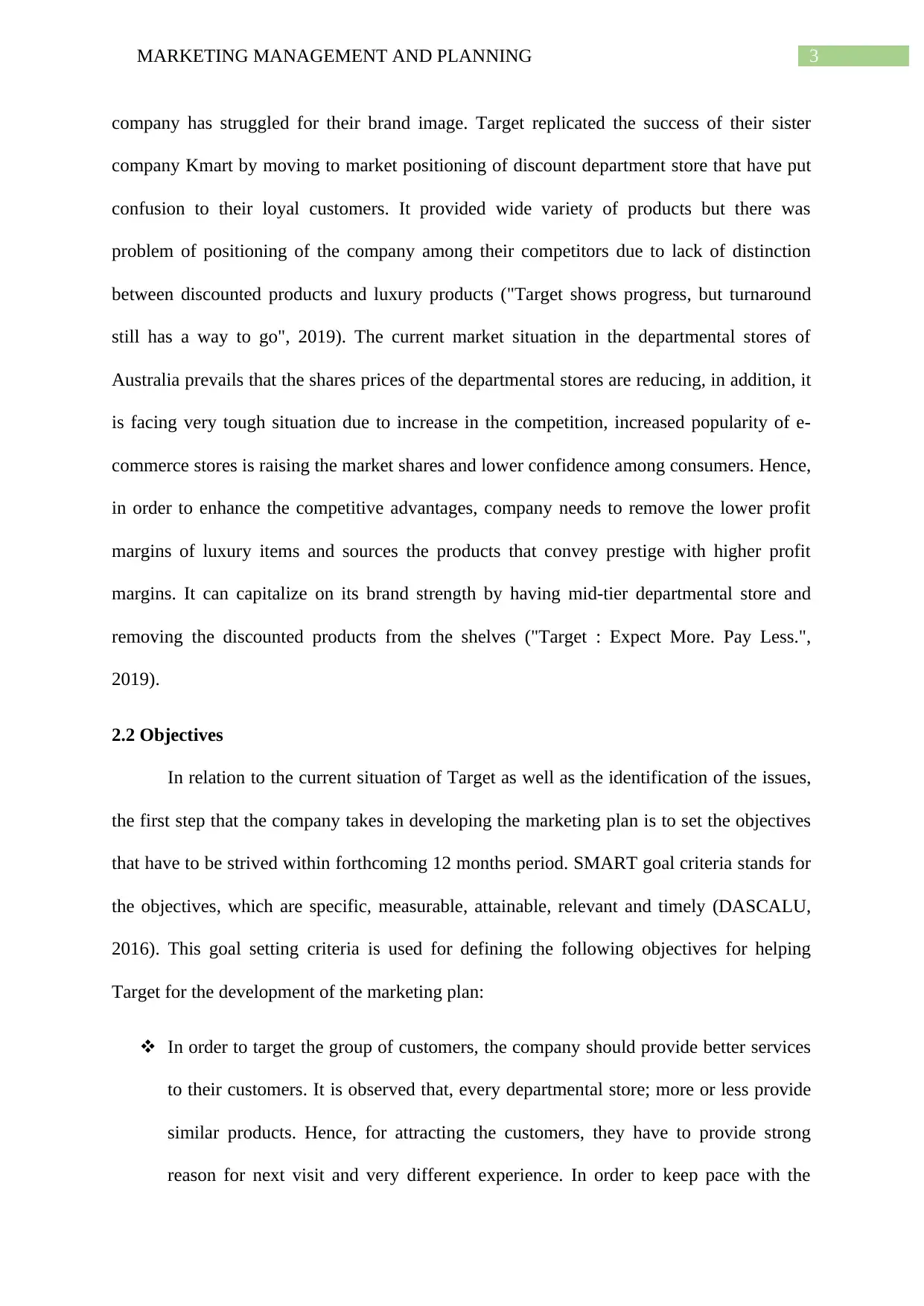
3MARKETING MANAGEMENT AND PLANNING
company has struggled for their brand image. Target replicated the success of their sister
company Kmart by moving to market positioning of discount department store that have put
confusion to their loyal customers. It provided wide variety of products but there was
problem of positioning of the company among their competitors due to lack of distinction
between discounted products and luxury products ("Target shows progress, but turnaround
still has a way to go", 2019). The current market situation in the departmental stores of
Australia prevails that the shares prices of the departmental stores are reducing, in addition, it
is facing very tough situation due to increase in the competition, increased popularity of e-
commerce stores is raising the market shares and lower confidence among consumers. Hence,
in order to enhance the competitive advantages, company needs to remove the lower profit
margins of luxury items and sources the products that convey prestige with higher profit
margins. It can capitalize on its brand strength by having mid-tier departmental store and
removing the discounted products from the shelves ("Target : Expect More. Pay Less.",
2019).
2.2 Objectives
In relation to the current situation of Target as well as the identification of the issues,
the first step that the company takes in developing the marketing plan is to set the objectives
that have to be strived within forthcoming 12 months period. SMART goal criteria stands for
the objectives, which are specific, measurable, attainable, relevant and timely (DASCALU,
2016). This goal setting criteria is used for defining the following objectives for helping
Target for the development of the marketing plan:
In order to target the group of customers, the company should provide better services
to their customers. It is observed that, every departmental store; more or less provide
similar products. Hence, for attracting the customers, they have to provide strong
reason for next visit and very different experience. In order to keep pace with the
company has struggled for their brand image. Target replicated the success of their sister
company Kmart by moving to market positioning of discount department store that have put
confusion to their loyal customers. It provided wide variety of products but there was
problem of positioning of the company among their competitors due to lack of distinction
between discounted products and luxury products ("Target shows progress, but turnaround
still has a way to go", 2019). The current market situation in the departmental stores of
Australia prevails that the shares prices of the departmental stores are reducing, in addition, it
is facing very tough situation due to increase in the competition, increased popularity of e-
commerce stores is raising the market shares and lower confidence among consumers. Hence,
in order to enhance the competitive advantages, company needs to remove the lower profit
margins of luxury items and sources the products that convey prestige with higher profit
margins. It can capitalize on its brand strength by having mid-tier departmental store and
removing the discounted products from the shelves ("Target : Expect More. Pay Less.",
2019).
2.2 Objectives
In relation to the current situation of Target as well as the identification of the issues,
the first step that the company takes in developing the marketing plan is to set the objectives
that have to be strived within forthcoming 12 months period. SMART goal criteria stands for
the objectives, which are specific, measurable, attainable, relevant and timely (DASCALU,
2016). This goal setting criteria is used for defining the following objectives for helping
Target for the development of the marketing plan:
In order to target the group of customers, the company should provide better services
to their customers. It is observed that, every departmental store; more or less provide
similar products. Hence, for attracting the customers, they have to provide strong
reason for next visit and very different experience. In order to keep pace with the
Paraphrase This Document
Need a fresh take? Get an instant paraphrase of this document with our AI Paraphraser
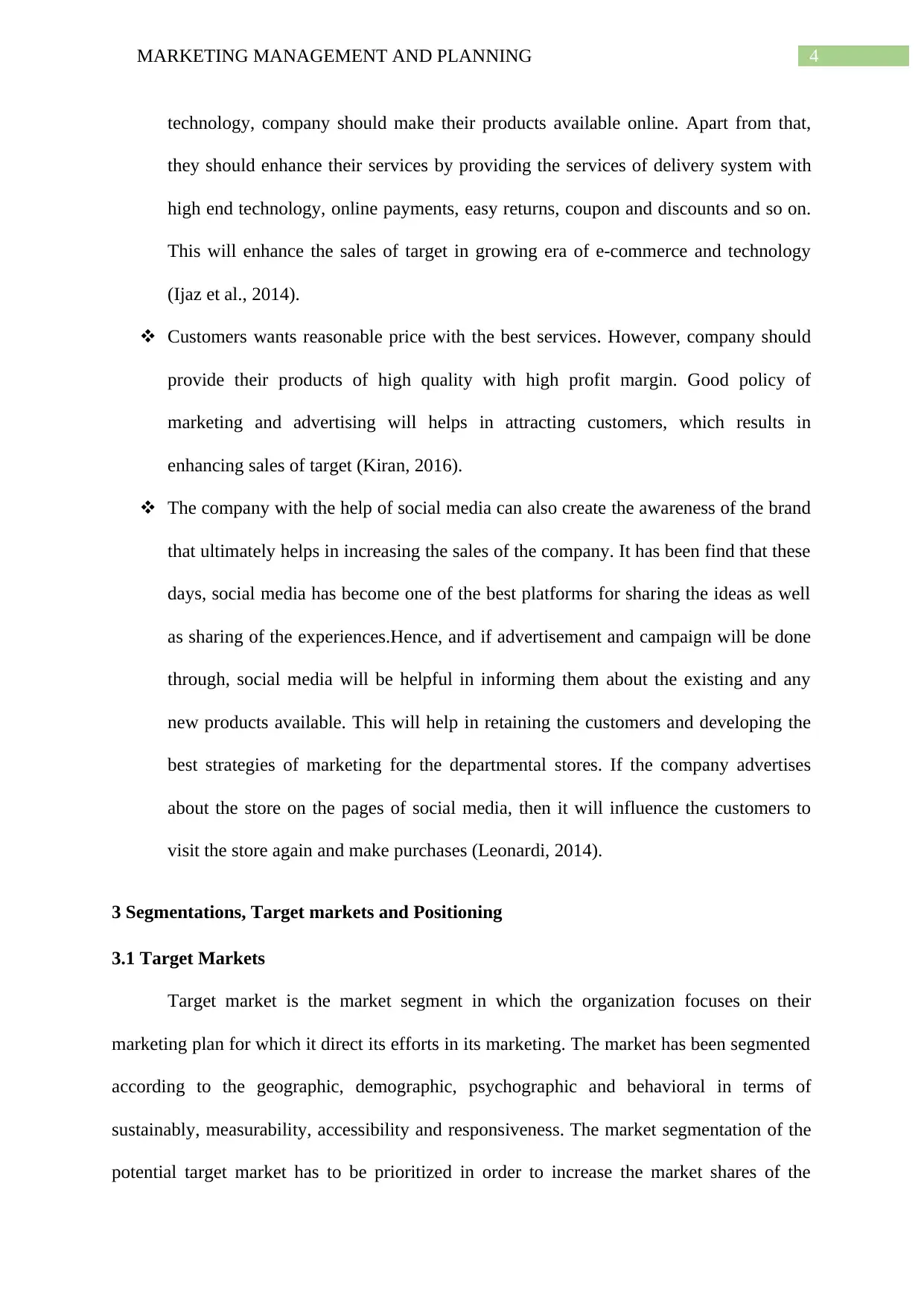
4MARKETING MANAGEMENT AND PLANNING
technology, company should make their products available online. Apart from that,
they should enhance their services by providing the services of delivery system with
high end technology, online payments, easy returns, coupon and discounts and so on.
This will enhance the sales of target in growing era of e-commerce and technology
(Ijaz et al., 2014).
Customers wants reasonable price with the best services. However, company should
provide their products of high quality with high profit margin. Good policy of
marketing and advertising will helps in attracting customers, which results in
enhancing sales of target (Kiran, 2016).
The company with the help of social media can also create the awareness of the brand
that ultimately helps in increasing the sales of the company. It has been find that these
days, social media has become one of the best platforms for sharing the ideas as well
as sharing of the experiences.Hence, and if advertisement and campaign will be done
through, social media will be helpful in informing them about the existing and any
new products available. This will help in retaining the customers and developing the
best strategies of marketing for the departmental stores. If the company advertises
about the store on the pages of social media, then it will influence the customers to
visit the store again and make purchases (Leonardi, 2014).
3 Segmentations, Target markets and Positioning
3.1 Target Markets
Target market is the market segment in which the organization focuses on their
marketing plan for which it direct its efforts in its marketing. The market has been segmented
according to the geographic, demographic, psychographic and behavioral in terms of
sustainably, measurability, accessibility and responsiveness. The market segmentation of the
potential target market has to be prioritized in order to increase the market shares of the
technology, company should make their products available online. Apart from that,
they should enhance their services by providing the services of delivery system with
high end technology, online payments, easy returns, coupon and discounts and so on.
This will enhance the sales of target in growing era of e-commerce and technology
(Ijaz et al., 2014).
Customers wants reasonable price with the best services. However, company should
provide their products of high quality with high profit margin. Good policy of
marketing and advertising will helps in attracting customers, which results in
enhancing sales of target (Kiran, 2016).
The company with the help of social media can also create the awareness of the brand
that ultimately helps in increasing the sales of the company. It has been find that these
days, social media has become one of the best platforms for sharing the ideas as well
as sharing of the experiences.Hence, and if advertisement and campaign will be done
through, social media will be helpful in informing them about the existing and any
new products available. This will help in retaining the customers and developing the
best strategies of marketing for the departmental stores. If the company advertises
about the store on the pages of social media, then it will influence the customers to
visit the store again and make purchases (Leonardi, 2014).
3 Segmentations, Target markets and Positioning
3.1 Target Markets
Target market is the market segment in which the organization focuses on their
marketing plan for which it direct its efforts in its marketing. The market has been segmented
according to the geographic, demographic, psychographic and behavioral in terms of
sustainably, measurability, accessibility and responsiveness. The market segmentation of the
potential target market has to be prioritized in order to increase the market shares of the
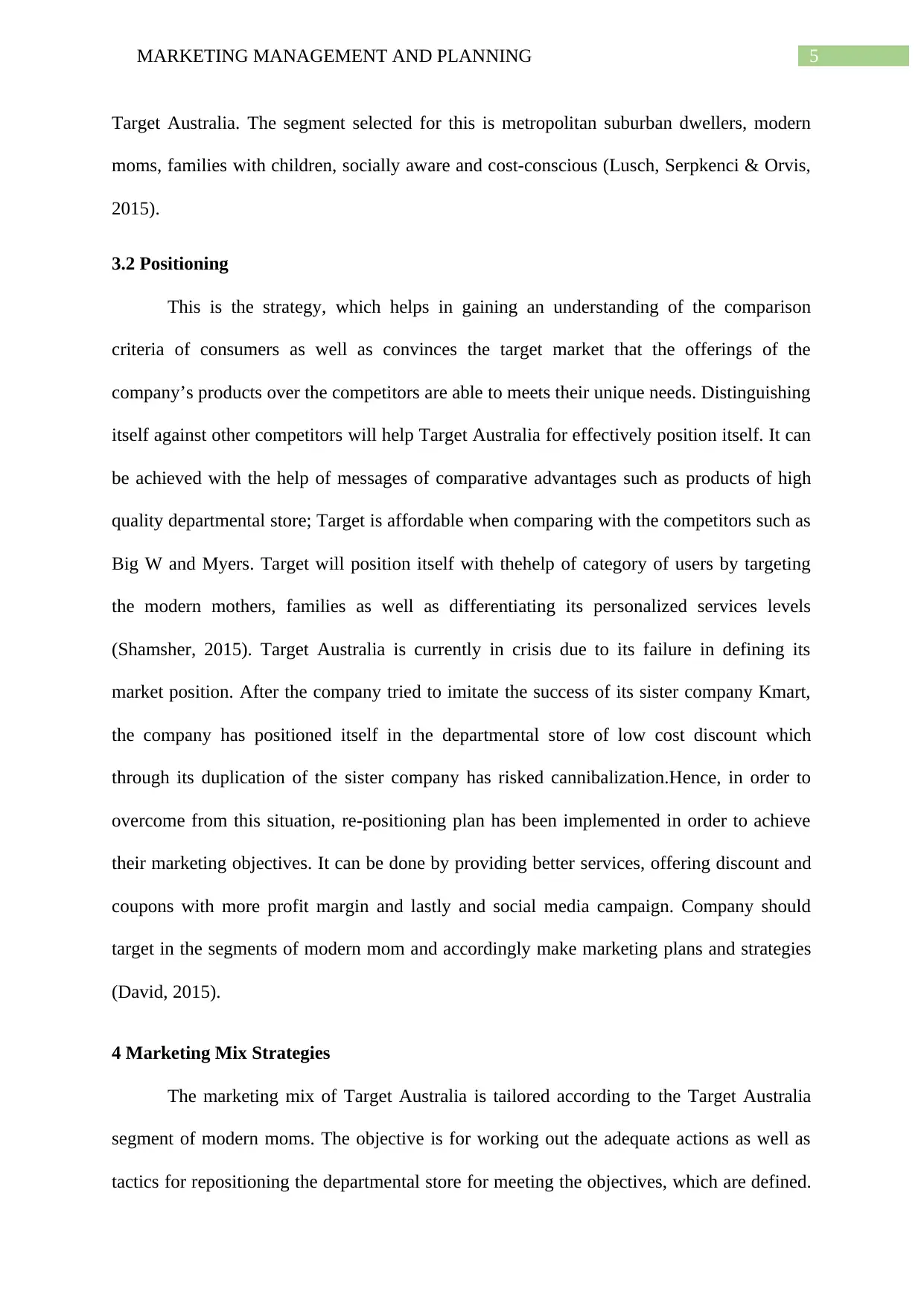
5MARKETING MANAGEMENT AND PLANNING
Target Australia. The segment selected for this is metropolitan suburban dwellers, modern
moms, families with children, socially aware and cost-conscious (Lusch, Serpkenci & Orvis,
2015).
3.2 Positioning
This is the strategy, which helps in gaining an understanding of the comparison
criteria of consumers as well as convinces the target market that the offerings of the
company’s products over the competitors are able to meets their unique needs. Distinguishing
itself against other competitors will help Target Australia for effectively position itself. It can
be achieved with the help of messages of comparative advantages such as products of high
quality departmental store; Target is affordable when comparing with the competitors such as
Big W and Myers. Target will position itself with thehelp of category of users by targeting
the modern mothers, families as well as differentiating its personalized services levels
(Shamsher, 2015). Target Australia is currently in crisis due to its failure in defining its
market position. After the company tried to imitate the success of its sister company Kmart,
the company has positioned itself in the departmental store of low cost discount which
through its duplication of the sister company has risked cannibalization.Hence, in order to
overcome from this situation, re-positioning plan has been implemented in order to achieve
their marketing objectives. It can be done by providing better services, offering discount and
coupons with more profit margin and lastly and social media campaign. Company should
target in the segments of modern mom and accordingly make marketing plans and strategies
(David, 2015).
4 Marketing Mix Strategies
The marketing mix of Target Australia is tailored according to the Target Australia
segment of modern moms. The objective is for working out the adequate actions as well as
tactics for repositioning the departmental store for meeting the objectives, which are defined.
Target Australia. The segment selected for this is metropolitan suburban dwellers, modern
moms, families with children, socially aware and cost-conscious (Lusch, Serpkenci & Orvis,
2015).
3.2 Positioning
This is the strategy, which helps in gaining an understanding of the comparison
criteria of consumers as well as convinces the target market that the offerings of the
company’s products over the competitors are able to meets their unique needs. Distinguishing
itself against other competitors will help Target Australia for effectively position itself. It can
be achieved with the help of messages of comparative advantages such as products of high
quality departmental store; Target is affordable when comparing with the competitors such as
Big W and Myers. Target will position itself with thehelp of category of users by targeting
the modern mothers, families as well as differentiating its personalized services levels
(Shamsher, 2015). Target Australia is currently in crisis due to its failure in defining its
market position. After the company tried to imitate the success of its sister company Kmart,
the company has positioned itself in the departmental store of low cost discount which
through its duplication of the sister company has risked cannibalization.Hence, in order to
overcome from this situation, re-positioning plan has been implemented in order to achieve
their marketing objectives. It can be done by providing better services, offering discount and
coupons with more profit margin and lastly and social media campaign. Company should
target in the segments of modern mom and accordingly make marketing plans and strategies
(David, 2015).
4 Marketing Mix Strategies
The marketing mix of Target Australia is tailored according to the Target Australia
segment of modern moms. The objective is for working out the adequate actions as well as
tactics for repositioning the departmental store for meeting the objectives, which are defined.
⊘ This is a preview!⊘
Do you want full access?
Subscribe today to unlock all pages.

Trusted by 1+ million students worldwide
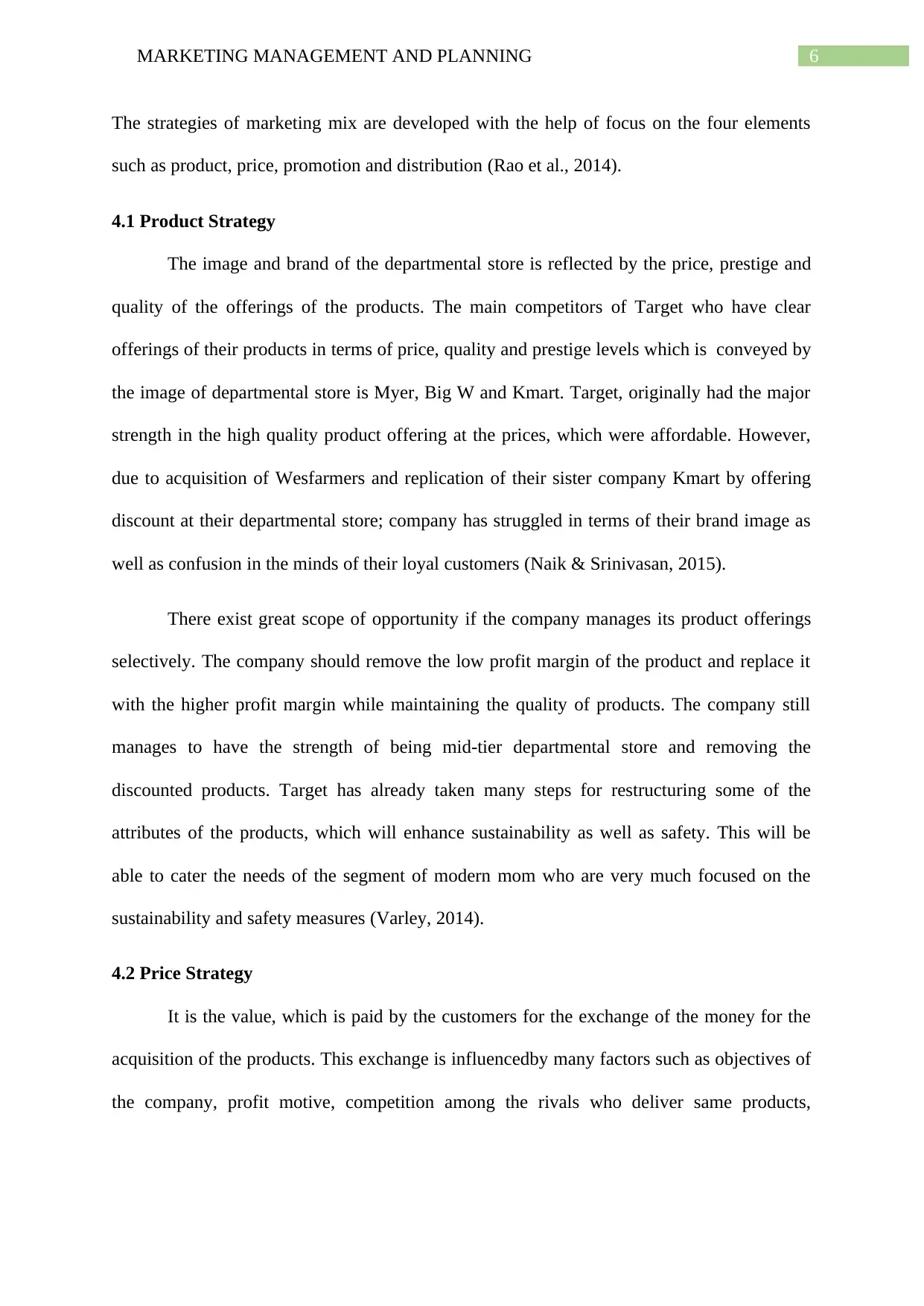
6MARKETING MANAGEMENT AND PLANNING
The strategies of marketing mix are developed with the help of focus on the four elements
such as product, price, promotion and distribution (Rao et al., 2014).
4.1 Product Strategy
The image and brand of the departmental store is reflected by the price, prestige and
quality of the offerings of the products. The main competitors of Target who have clear
offerings of their products in terms of price, quality and prestige levels which is conveyed by
the image of departmental store is Myer, Big W and Kmart. Target, originally had the major
strength in the high quality product offering at the prices, which were affordable. However,
due to acquisition of Wesfarmers and replication of their sister company Kmart by offering
discount at their departmental store; company has struggled in terms of their brand image as
well as confusion in the minds of their loyal customers (Naik & Srinivasan, 2015).
There exist great scope of opportunity if the company manages its product offerings
selectively. The company should remove the low profit margin of the product and replace it
with the higher profit margin while maintaining the quality of products. The company still
manages to have the strength of being mid-tier departmental store and removing the
discounted products. Target has already taken many steps for restructuring some of the
attributes of the products, which will enhance sustainability as well as safety. This will be
able to cater the needs of the segment of modern mom who are very much focused on the
sustainability and safety measures (Varley, 2014).
4.2 Price Strategy
It is the value, which is paid by the customers for the exchange of the money for the
acquisition of the products. This exchange is influencedby many factors such as objectives of
the company, profit motive, competition among the rivals who deliver same products,
The strategies of marketing mix are developed with the help of focus on the four elements
such as product, price, promotion and distribution (Rao et al., 2014).
4.1 Product Strategy
The image and brand of the departmental store is reflected by the price, prestige and
quality of the offerings of the products. The main competitors of Target who have clear
offerings of their products in terms of price, quality and prestige levels which is conveyed by
the image of departmental store is Myer, Big W and Kmart. Target, originally had the major
strength in the high quality product offering at the prices, which were affordable. However,
due to acquisition of Wesfarmers and replication of their sister company Kmart by offering
discount at their departmental store; company has struggled in terms of their brand image as
well as confusion in the minds of their loyal customers (Naik & Srinivasan, 2015).
There exist great scope of opportunity if the company manages its product offerings
selectively. The company should remove the low profit margin of the product and replace it
with the higher profit margin while maintaining the quality of products. The company still
manages to have the strength of being mid-tier departmental store and removing the
discounted products. Target has already taken many steps for restructuring some of the
attributes of the products, which will enhance sustainability as well as safety. This will be
able to cater the needs of the segment of modern mom who are very much focused on the
sustainability and safety measures (Varley, 2014).
4.2 Price Strategy
It is the value, which is paid by the customers for the exchange of the money for the
acquisition of the products. This exchange is influencedby many factors such as objectives of
the company, profit motive, competition among the rivals who deliver same products,
Paraphrase This Document
Need a fresh take? Get an instant paraphrase of this document with our AI Paraphraser
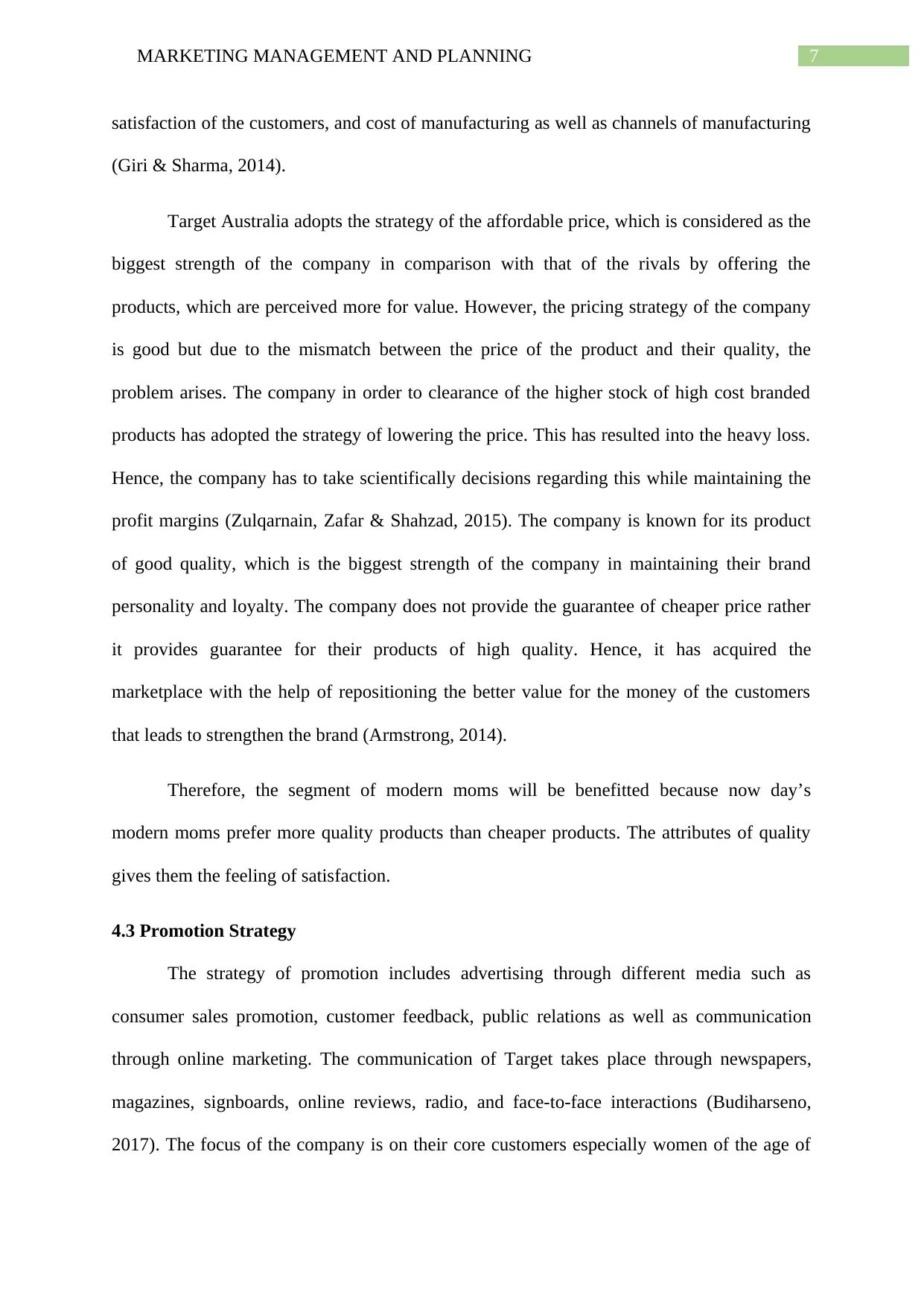
7MARKETING MANAGEMENT AND PLANNING
satisfaction of the customers, and cost of manufacturing as well as channels of manufacturing
(Giri & Sharma, 2014).
Target Australia adopts the strategy of the affordable price, which is considered as the
biggest strength of the company in comparison with that of the rivals by offering the
products, which are perceived more for value. However, the pricing strategy of the company
is good but due to the mismatch between the price of the product and their quality, the
problem arises. The company in order to clearance of the higher stock of high cost branded
products has adopted the strategy of lowering the price. This has resulted into the heavy loss.
Hence, the company has to take scientifically decisions regarding this while maintaining the
profit margins (Zulqarnain, Zafar & Shahzad, 2015). The company is known for its product
of good quality, which is the biggest strength of the company in maintaining their brand
personality and loyalty. The company does not provide the guarantee of cheaper price rather
it provides guarantee for their products of high quality. Hence, it has acquired the
marketplace with the help of repositioning the better value for the money of the customers
that leads to strengthen the brand (Armstrong, 2014).
Therefore, the segment of modern moms will be benefitted because now day’s
modern moms prefer more quality products than cheaper products. The attributes of quality
gives them the feeling of satisfaction.
4.3 Promotion Strategy
The strategy of promotion includes advertising through different media such as
consumer sales promotion, customer feedback, public relations as well as communication
through online marketing. The communication of Target takes place through newspapers,
magazines, signboards, online reviews, radio, and face-to-face interactions (Budiharseno,
2017). The focus of the company is on their core customers especially women of the age of
satisfaction of the customers, and cost of manufacturing as well as channels of manufacturing
(Giri & Sharma, 2014).
Target Australia adopts the strategy of the affordable price, which is considered as the
biggest strength of the company in comparison with that of the rivals by offering the
products, which are perceived more for value. However, the pricing strategy of the company
is good but due to the mismatch between the price of the product and their quality, the
problem arises. The company in order to clearance of the higher stock of high cost branded
products has adopted the strategy of lowering the price. This has resulted into the heavy loss.
Hence, the company has to take scientifically decisions regarding this while maintaining the
profit margins (Zulqarnain, Zafar & Shahzad, 2015). The company is known for its product
of good quality, which is the biggest strength of the company in maintaining their brand
personality and loyalty. The company does not provide the guarantee of cheaper price rather
it provides guarantee for their products of high quality. Hence, it has acquired the
marketplace with the help of repositioning the better value for the money of the customers
that leads to strengthen the brand (Armstrong, 2014).
Therefore, the segment of modern moms will be benefitted because now day’s
modern moms prefer more quality products than cheaper products. The attributes of quality
gives them the feeling of satisfaction.
4.3 Promotion Strategy
The strategy of promotion includes advertising through different media such as
consumer sales promotion, customer feedback, public relations as well as communication
through online marketing. The communication of Target takes place through newspapers,
magazines, signboards, online reviews, radio, and face-to-face interactions (Budiharseno,
2017). The focus of the company is on their core customers especially women of the age of
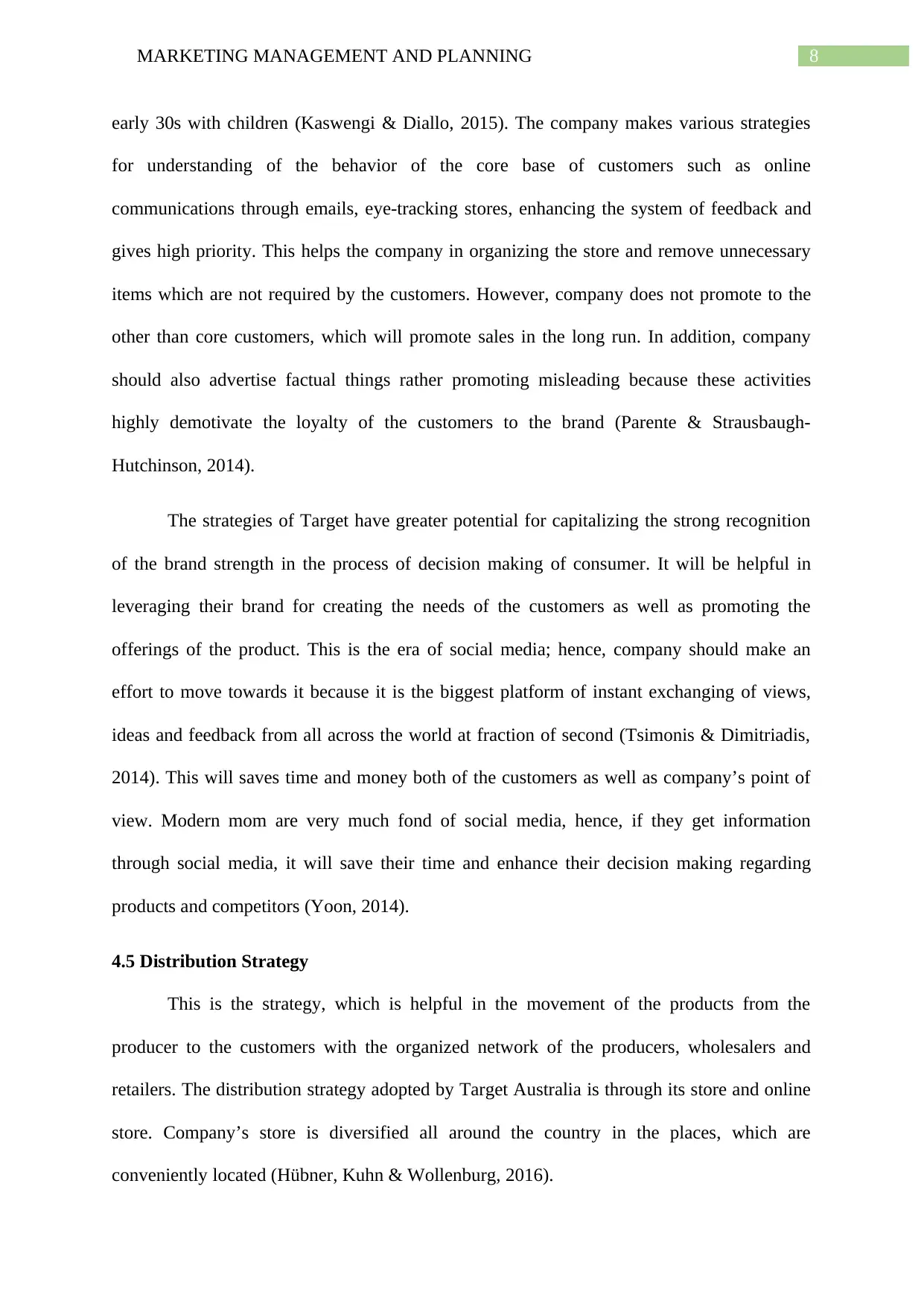
8MARKETING MANAGEMENT AND PLANNING
early 30s with children (Kaswengi & Diallo, 2015). The company makes various strategies
for understanding of the behavior of the core base of customers such as online
communications through emails, eye-tracking stores, enhancing the system of feedback and
gives high priority. This helps the company in organizing the store and remove unnecessary
items which are not required by the customers. However, company does not promote to the
other than core customers, which will promote sales in the long run. In addition, company
should also advertise factual things rather promoting misleading because these activities
highly demotivate the loyalty of the customers to the brand (Parente & Strausbaugh-
Hutchinson, 2014).
The strategies of Target have greater potential for capitalizing the strong recognition
of the brand strength in the process of decision making of consumer. It will be helpful in
leveraging their brand for creating the needs of the customers as well as promoting the
offerings of the product. This is the era of social media; hence, company should make an
effort to move towards it because it is the biggest platform of instant exchanging of views,
ideas and feedback from all across the world at fraction of second (Tsimonis & Dimitriadis,
2014). This will saves time and money both of the customers as well as company’s point of
view. Modern mom are very much fond of social media, hence, if they get information
through social media, it will save their time and enhance their decision making regarding
products and competitors (Yoon, 2014).
4.5 Distribution Strategy
This is the strategy, which is helpful in the movement of the products from the
producer to the customers with the organized network of the producers, wholesalers and
retailers. The distribution strategy adopted by Target Australia is through its store and online
store. Company’s store is diversified all around the country in the places, which are
conveniently located (Hübner, Kuhn & Wollenburg, 2016).
early 30s with children (Kaswengi & Diallo, 2015). The company makes various strategies
for understanding of the behavior of the core base of customers such as online
communications through emails, eye-tracking stores, enhancing the system of feedback and
gives high priority. This helps the company in organizing the store and remove unnecessary
items which are not required by the customers. However, company does not promote to the
other than core customers, which will promote sales in the long run. In addition, company
should also advertise factual things rather promoting misleading because these activities
highly demotivate the loyalty of the customers to the brand (Parente & Strausbaugh-
Hutchinson, 2014).
The strategies of Target have greater potential for capitalizing the strong recognition
of the brand strength in the process of decision making of consumer. It will be helpful in
leveraging their brand for creating the needs of the customers as well as promoting the
offerings of the product. This is the era of social media; hence, company should make an
effort to move towards it because it is the biggest platform of instant exchanging of views,
ideas and feedback from all across the world at fraction of second (Tsimonis & Dimitriadis,
2014). This will saves time and money both of the customers as well as company’s point of
view. Modern mom are very much fond of social media, hence, if they get information
through social media, it will save their time and enhance their decision making regarding
products and competitors (Yoon, 2014).
4.5 Distribution Strategy
This is the strategy, which is helpful in the movement of the products from the
producer to the customers with the organized network of the producers, wholesalers and
retailers. The distribution strategy adopted by Target Australia is through its store and online
store. Company’s store is diversified all around the country in the places, which are
conveniently located (Hübner, Kuhn & Wollenburg, 2016).
⊘ This is a preview!⊘
Do you want full access?
Subscribe today to unlock all pages.

Trusted by 1+ million students worldwide
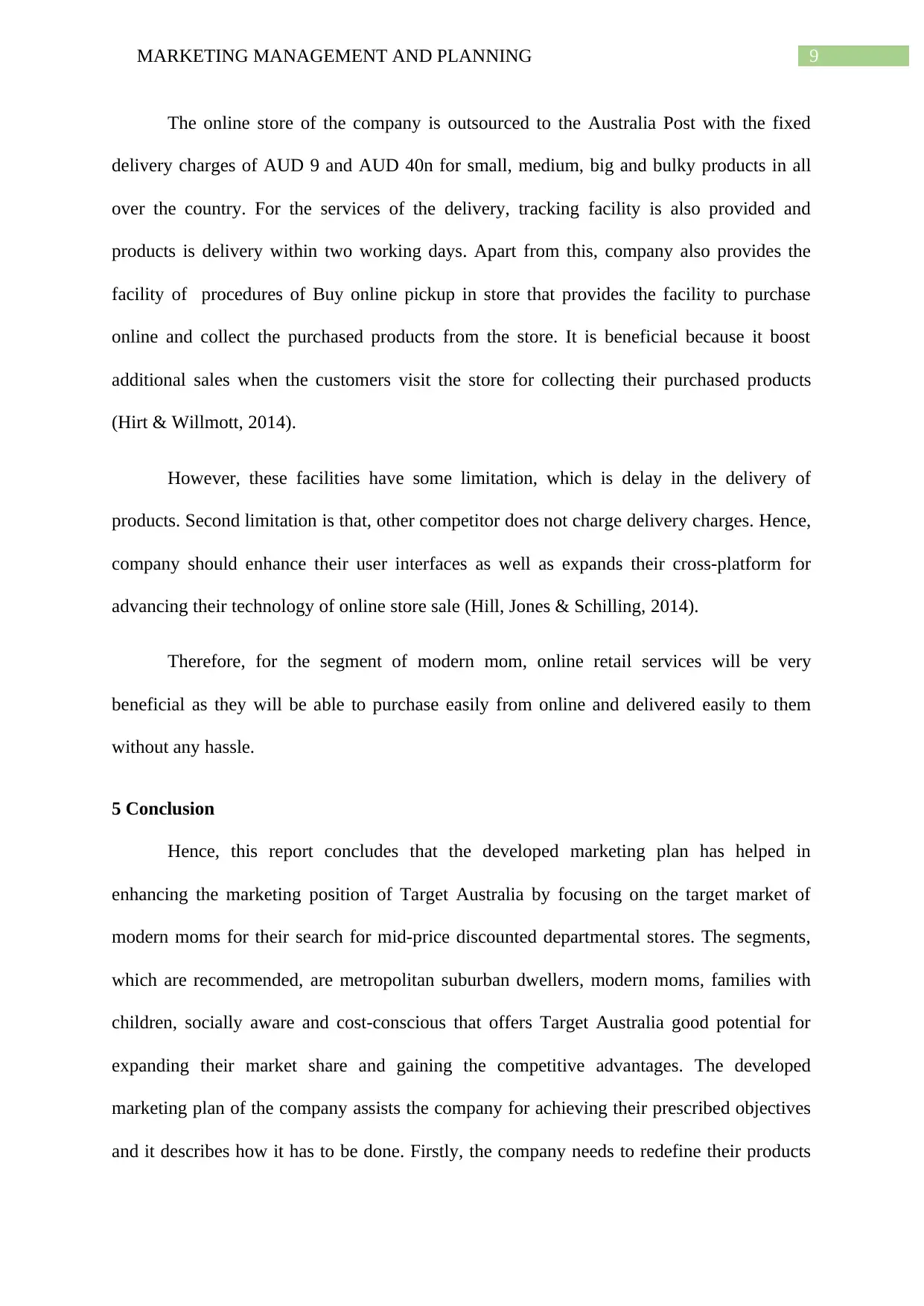
9MARKETING MANAGEMENT AND PLANNING
The online store of the company is outsourced to the Australia Post with the fixed
delivery charges of AUD 9 and AUD 40n for small, medium, big and bulky products in all
over the country. For the services of the delivery, tracking facility is also provided and
products is delivery within two working days. Apart from this, company also provides the
facility of procedures of Buy online pickup in store that provides the facility to purchase
online and collect the purchased products from the store. It is beneficial because it boost
additional sales when the customers visit the store for collecting their purchased products
(Hirt & Willmott, 2014).
However, these facilities have some limitation, which is delay in the delivery of
products. Second limitation is that, other competitor does not charge delivery charges. Hence,
company should enhance their user interfaces as well as expands their cross-platform for
advancing their technology of online store sale (Hill, Jones & Schilling, 2014).
Therefore, for the segment of modern mom, online retail services will be very
beneficial as they will be able to purchase easily from online and delivered easily to them
without any hassle.
5 Conclusion
Hence, this report concludes that the developed marketing plan has helped in
enhancing the marketing position of Target Australia by focusing on the target market of
modern moms for their search for mid-price discounted departmental stores. The segments,
which are recommended, are metropolitan suburban dwellers, modern moms, families with
children, socially aware and cost-conscious that offers Target Australia good potential for
expanding their market share and gaining the competitive advantages. The developed
marketing plan of the company assists the company for achieving their prescribed objectives
and it describes how it has to be done. Firstly, the company needs to redefine their products
The online store of the company is outsourced to the Australia Post with the fixed
delivery charges of AUD 9 and AUD 40n for small, medium, big and bulky products in all
over the country. For the services of the delivery, tracking facility is also provided and
products is delivery within two working days. Apart from this, company also provides the
facility of procedures of Buy online pickup in store that provides the facility to purchase
online and collect the purchased products from the store. It is beneficial because it boost
additional sales when the customers visit the store for collecting their purchased products
(Hirt & Willmott, 2014).
However, these facilities have some limitation, which is delay in the delivery of
products. Second limitation is that, other competitor does not charge delivery charges. Hence,
company should enhance their user interfaces as well as expands their cross-platform for
advancing their technology of online store sale (Hill, Jones & Schilling, 2014).
Therefore, for the segment of modern mom, online retail services will be very
beneficial as they will be able to purchase easily from online and delivered easily to them
without any hassle.
5 Conclusion
Hence, this report concludes that the developed marketing plan has helped in
enhancing the marketing position of Target Australia by focusing on the target market of
modern moms for their search for mid-price discounted departmental stores. The segments,
which are recommended, are metropolitan suburban dwellers, modern moms, families with
children, socially aware and cost-conscious that offers Target Australia good potential for
expanding their market share and gaining the competitive advantages. The developed
marketing plan of the company assists the company for achieving their prescribed objectives
and it describes how it has to be done. Firstly, the company needs to redefine their products
Paraphrase This Document
Need a fresh take? Get an instant paraphrase of this document with our AI Paraphraser
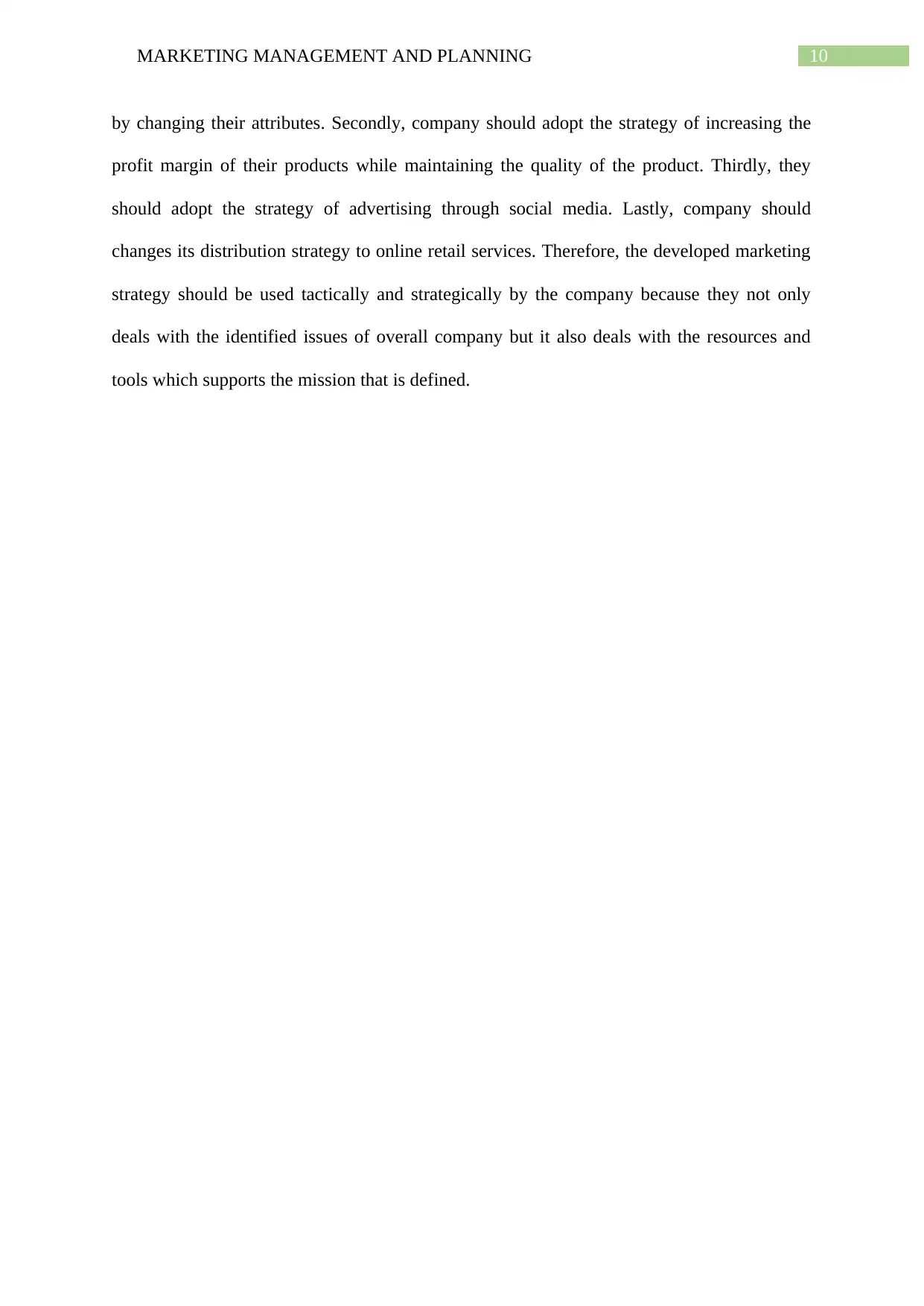
10MARKETING MANAGEMENT AND PLANNING
by changing their attributes. Secondly, company should adopt the strategy of increasing the
profit margin of their products while maintaining the quality of the product. Thirdly, they
should adopt the strategy of advertising through social media. Lastly, company should
changes its distribution strategy to online retail services. Therefore, the developed marketing
strategy should be used tactically and strategically by the company because they not only
deals with the identified issues of overall company but it also deals with the resources and
tools which supports the mission that is defined.
by changing their attributes. Secondly, company should adopt the strategy of increasing the
profit margin of their products while maintaining the quality of the product. Thirdly, they
should adopt the strategy of advertising through social media. Lastly, company should
changes its distribution strategy to online retail services. Therefore, the developed marketing
strategy should be used tactically and strategically by the company because they not only
deals with the identified issues of overall company but it also deals with the resources and
tools which supports the mission that is defined.
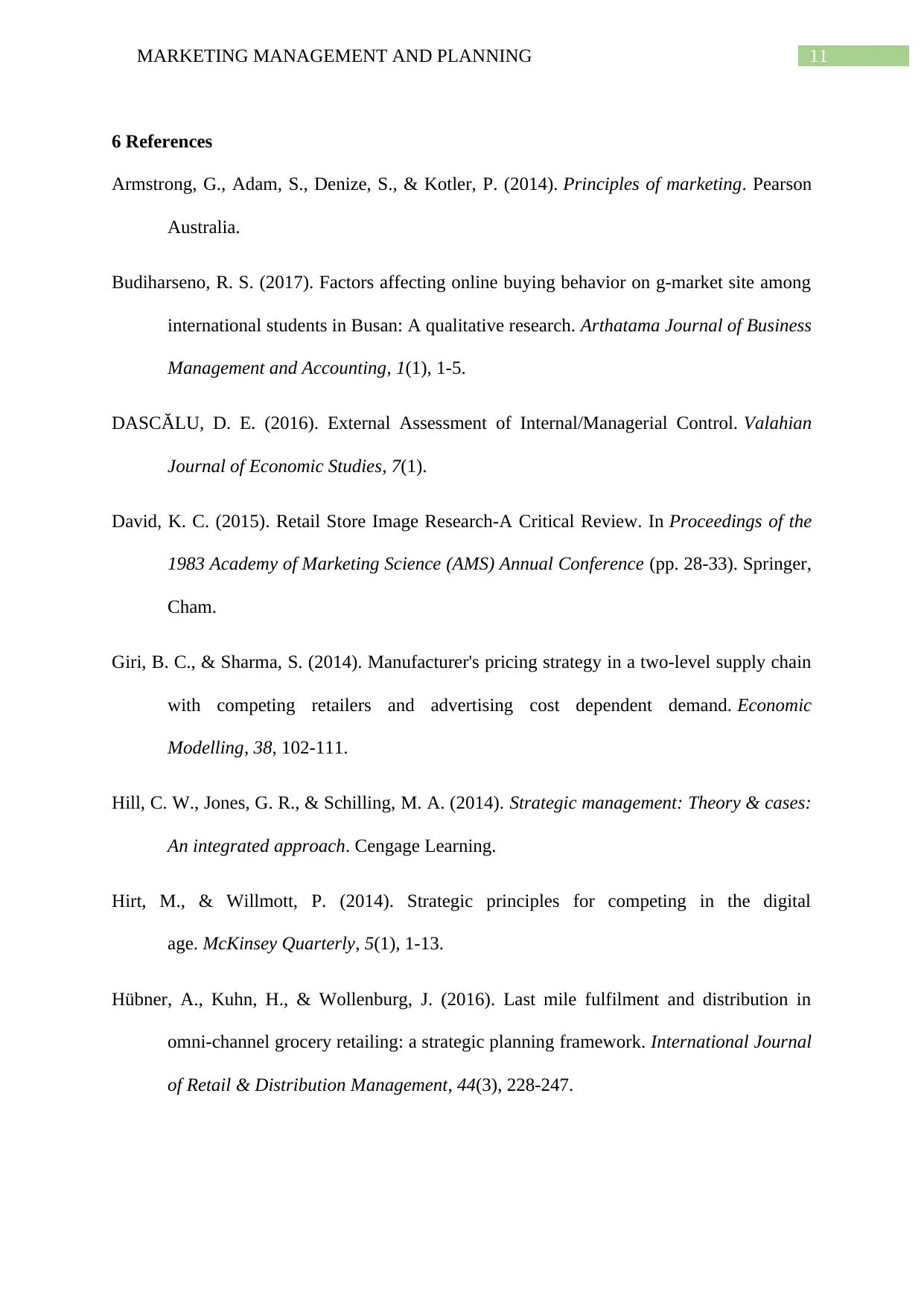
11MARKETING MANAGEMENT AND PLANNING
6 References
Armstrong, G., Adam, S., Denize, S., & Kotler, P. (2014). Principles of marketing. Pearson
Australia.
Budiharseno, R. S. (2017). Factors affecting online buying behavior on g-market site among
international students in Busan: A qualitative research. Arthatama Journal of Business
Management and Accounting, 1(1), 1-5.
DASCĂLU, D. E. (2016). External Assessment of Internal/Managerial Control. Valahian
Journal of Economic Studies, 7(1).
David, K. C. (2015). Retail Store Image Research-A Critical Review. In Proceedings of the
1983 Academy of Marketing Science (AMS) Annual Conference (pp. 28-33). Springer,
Cham.
Giri, B. C., & Sharma, S. (2014). Manufacturer's pricing strategy in a two-level supply chain
with competing retailers and advertising cost dependent demand. Economic
Modelling, 38, 102-111.
Hill, C. W., Jones, G. R., & Schilling, M. A. (2014). Strategic management: Theory & cases:
An integrated approach. Cengage Learning.
Hirt, M., & Willmott, P. (2014). Strategic principles for competing in the digital
age. McKinsey Quarterly, 5(1), 1-13.
Hübner, A., Kuhn, H., & Wollenburg, J. (2016). Last mile fulfilment and distribution in
omni-channel grocery retailing: a strategic planning framework. International Journal
of Retail & Distribution Management, 44(3), 228-247.
6 References
Armstrong, G., Adam, S., Denize, S., & Kotler, P. (2014). Principles of marketing. Pearson
Australia.
Budiharseno, R. S. (2017). Factors affecting online buying behavior on g-market site among
international students in Busan: A qualitative research. Arthatama Journal of Business
Management and Accounting, 1(1), 1-5.
DASCĂLU, D. E. (2016). External Assessment of Internal/Managerial Control. Valahian
Journal of Economic Studies, 7(1).
David, K. C. (2015). Retail Store Image Research-A Critical Review. In Proceedings of the
1983 Academy of Marketing Science (AMS) Annual Conference (pp. 28-33). Springer,
Cham.
Giri, B. C., & Sharma, S. (2014). Manufacturer's pricing strategy in a two-level supply chain
with competing retailers and advertising cost dependent demand. Economic
Modelling, 38, 102-111.
Hill, C. W., Jones, G. R., & Schilling, M. A. (2014). Strategic management: Theory & cases:
An integrated approach. Cengage Learning.
Hirt, M., & Willmott, P. (2014). Strategic principles for competing in the digital
age. McKinsey Quarterly, 5(1), 1-13.
Hübner, A., Kuhn, H., & Wollenburg, J. (2016). Last mile fulfilment and distribution in
omni-channel grocery retailing: a strategic planning framework. International Journal
of Retail & Distribution Management, 44(3), 228-247.
⊘ This is a preview!⊘
Do you want full access?
Subscribe today to unlock all pages.

Trusted by 1+ million students worldwide
1 out of 15
Related Documents
Your All-in-One AI-Powered Toolkit for Academic Success.
+13062052269
info@desklib.com
Available 24*7 on WhatsApp / Email
![[object Object]](/_next/static/media/star-bottom.7253800d.svg)
Unlock your academic potential
Copyright © 2020–2025 A2Z Services. All Rights Reserved. Developed and managed by ZUCOL.



